I adore hummingbirds. It’s lovely to have these tiny, jeweled visitors zipping around each year. Every spring, before I make the first batch of nectar and hang the feeders, I glance at the old note taped inside my recipe cabinet – the one that reminds me of the perfect sugar-to-water ratio.
Here’s the safe, bird-approved and expert-recommended recipe I’ve relied on for years . . .
Mix 1 part white sugar with 4 parts water. This mimics natural flower nectar without unnecessary additives like dye, honey, or brown sugar. This ratio keeps hummers healthy and returning. Overly sweet blends may seem tempting, and tend to build swarms around a feeder, but the 1:4 ratio keeps their little bodies safe and their visits consistent!
If you put out a feeder, try to keep it stocked so the birds can rely on it. Many will nest nearby or make your yard part of their daily routine once they’ve found a steady food source.
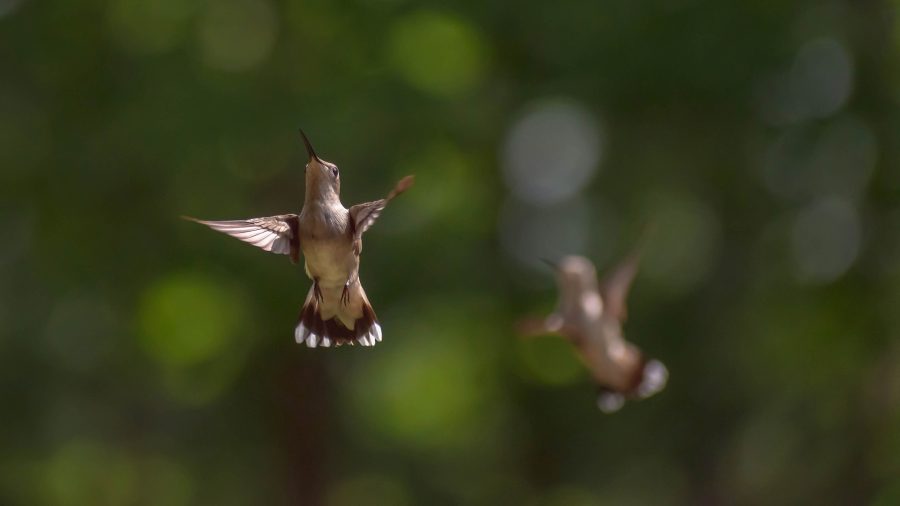
If you start offering a food source (nectar for hummers, seed for cardinals, suet for woodpeckers), plan to keep it going for the whole season. They’ll come to expect it, and suddenly removing it can leave them scrambling to find enough to eat, especially when they have chicks to feed.
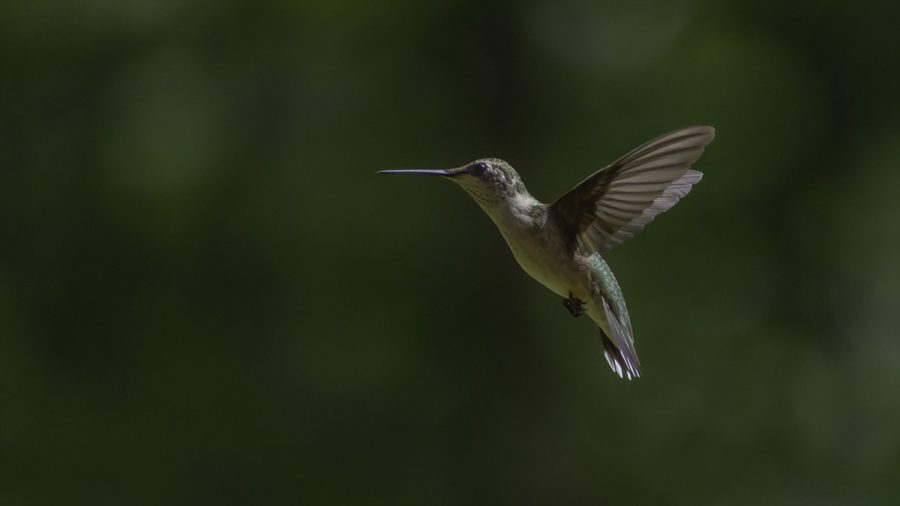
All of the hummingbird images in this article are my own. I’ve been putting out and maintaining hummingbird feeders every year since the early 2000s, and many of these photos are the result of patient spring and summer days spent watching and waiting.
Our Visitors Through the Season
We get lots of visiting hummers every year, most are Ruby-throated Hummingbirds. We generally start to see males sometime in March, scouting food sources ahead of the females perhaps. One of my favorite photos is the featured image at the top of this article. It’s not perfect, but you can definitely see the full red of his gorget and a bit of the depth of his green. And he’s in flight.
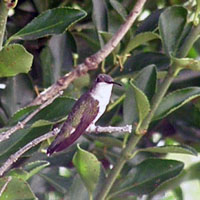
The females arrive shortly after, sometimes even chasing the males away from the feeders. They often linger in nearby bushes or tree limbs, keeping a diligent watch over the area.
I caught this little female hummer perched in a bush near our front porch, a reminder that once they’ve found a reliable feeder, they tend to hang out and nest nearby. If you put a feeder out, it’s kind to keep it going so that the little hummers who have found it can actually rely on it as a source of food.
Planting for Hummingbirds
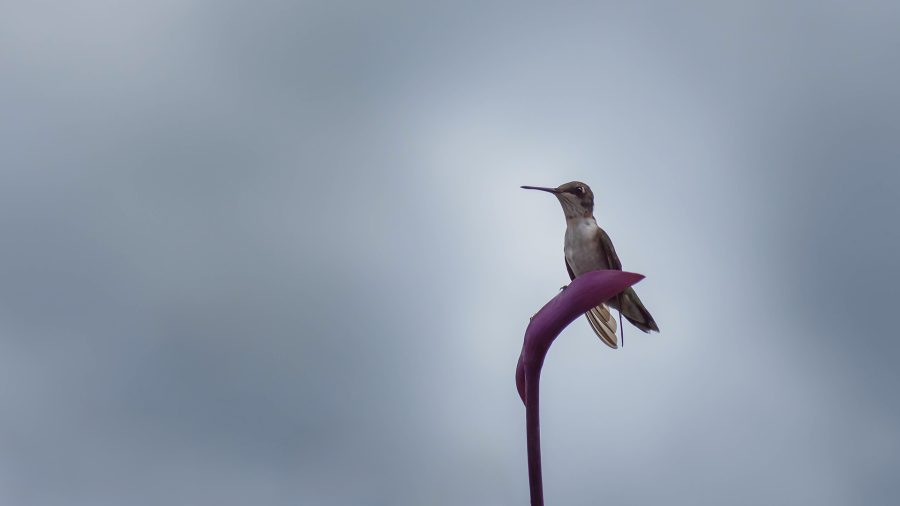
If you’re not able to maintain a feeder regularly, consider planting a hummingbird-friendly garden. We have three butterfly bushes and a few annuals to bring plenty of color and nectar to our yard, but I still keep feeders up.
As a general rule, trumpet-shaped flowers are irresistible to hummingbirds. Petunias, impatiens, and other nectar-rich blooms can also help attract them. I also have a trumpet vine, also known as a hummingbird vine (Campsis radicans) but I definitely need a new, safe place for it since its a beast of a grower. Hummers love the orange trumpet flowers. I’d also like to get my hands on some Coral honeysuckle (Lonicera sempervirens), I’ve heard it’s not as aggressive as other honeysuckle species and that hummers love it, too.
Making Homemade Hummingbird Food
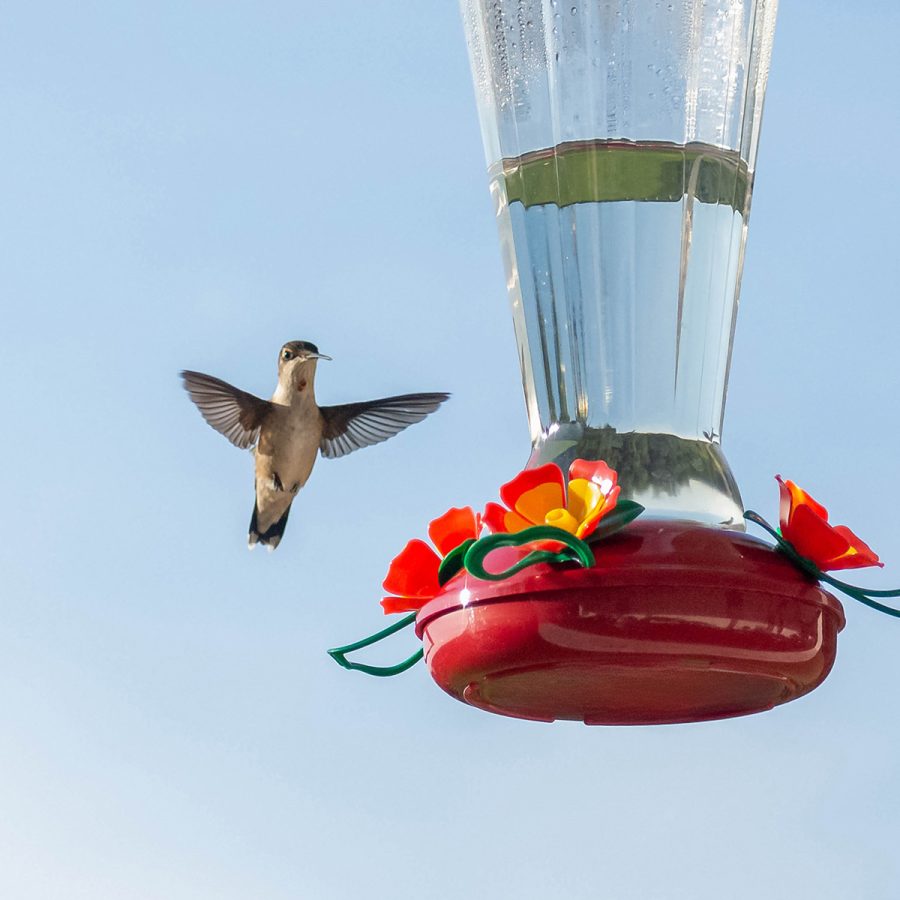
There’s no need to buy special, pre-made food. If you do, research the brand carefully before buying. Making your own is as easy as boiling water:
- Water – Fill a tea kettle or saucepan and bring it to a boil.
- Sugar – Use only pure white granulated cane sugar. Add ¼ cup sugar for every cup of boiling water.
I usually boil a full kettle, then measure 2 cups of sugar into a large glass mixing bowl. Once the water boils, I pour 8 cups into the bowl, stir until dissolved, and let it cool completely before filling the feeders.
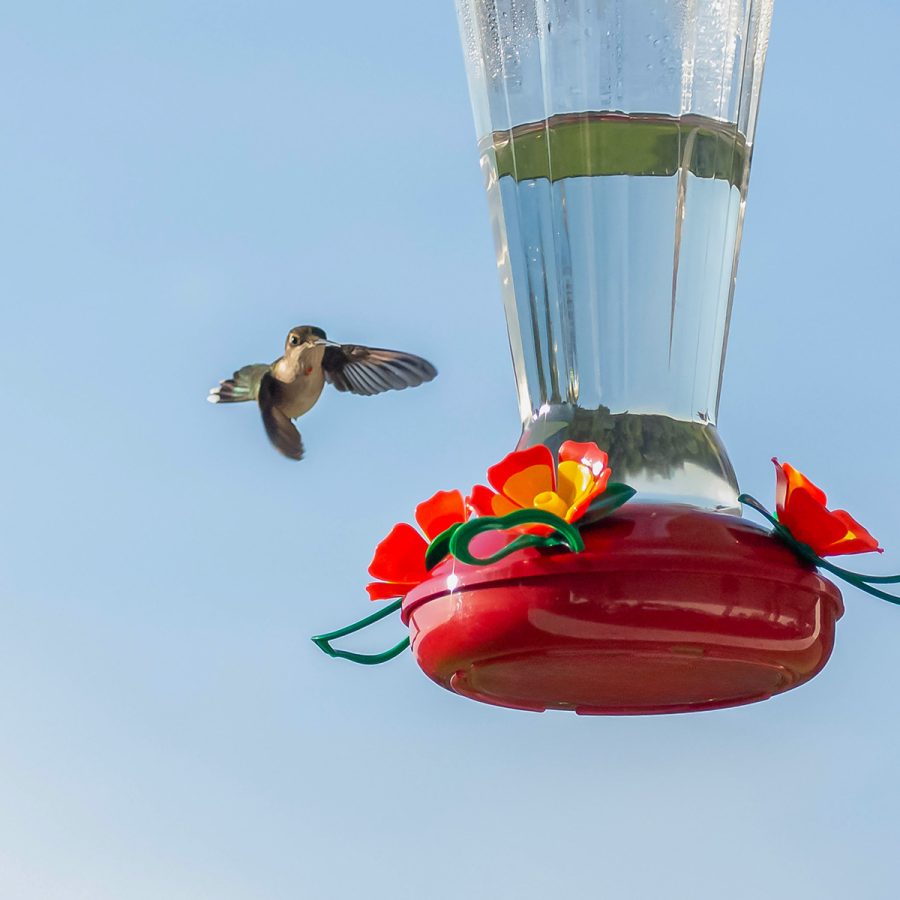
- Avoid honey, brown sugar, Jell-O, or food coloring.
- Clear nectar makes it easier to spot cloudiness or spoilage.
- Store extra nectar in the fridge for up to a week.
Is boiling the water necessary?
I like to boil the water as a precaution and to help the sugar dissolve quickly. I have heard it isn’t necessary, but it certainly doesn’t hurt and I’d rather be safe than sorry. It definitely doesn’t hurt to boil it and an electric kettle makes quick work of it.
Should I add red food coloring?
I’ve heard rumors about food coloring making their bills soft or causing tumors but I’m not sure if that’s true. What I do know to be true is that it’s not necessary for the liquid to be red at all! Hummers like the clear nectar just fine.
This full-page printable includes the 1:4 recipe, quick-reference measurement chart, and feeder-care tips.
Print it as-is for your recipe binder, or fold it in half for a handy card to keep by your feeders.
Finding The Perfect Hummingbird Feeders
I have gone through a lot of hummingbird feeders over the past 20+ years and honestly I still prefer the tough plastic ones that are easy to maintain, easy to clean, and easy to see through to the food from a distance.
I’ve purchased several from WalMart and Dollar General for under $10 over the years, and they serve the purpose just fine! They’re also affordable enough to replace when necessary.
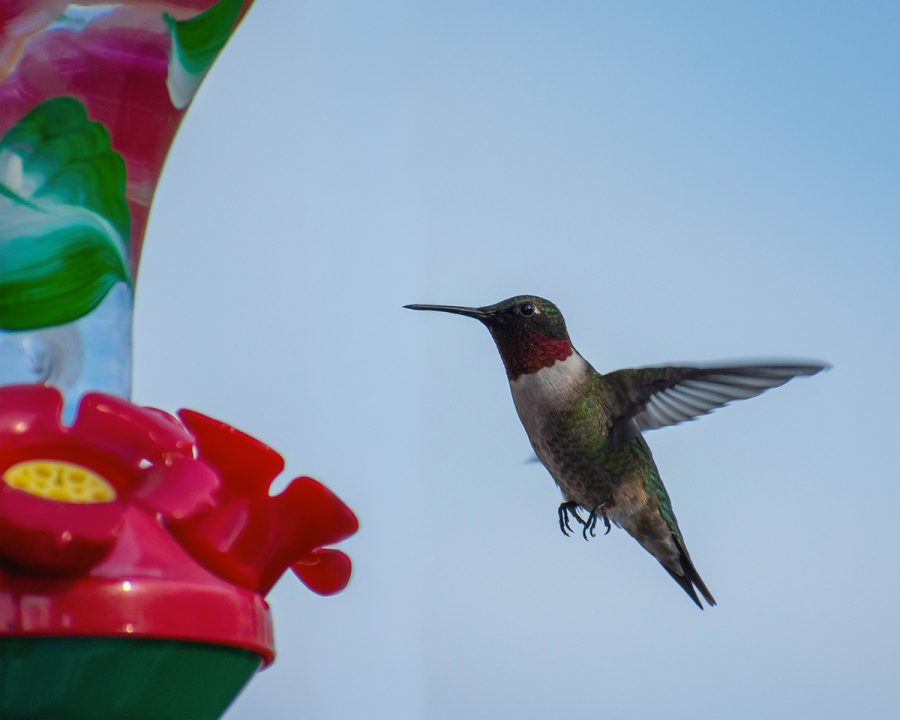
I’ve also had some really pretty light-bulb-shaped glass ones with hand-painted details. One of my favorite places to shop for feeders is actually Duncraft. The company is still family owned, still has a catalog, and has been selling online since 1996. They’ve got a huge variety of hummingbird feeders, from the plastic practical or unique ones to the fancy glass works of art. You can also pick up accessories like the cleaning brush sets, swab brushes, and replacement pieces like the little yellow bee guards.
No matter what kind of feeder you buy, or where you buy it from, make sure that it’ll hold enough of your sugar water to keep up with the number of birds you’ve got coming around. I tend to spend a smaller amount of money and replace them every year or two because they’re out in the weather and they fade and age.
You’ll also want to be sure your hummingbird feeder is easy to clean because it needs to be cleaned quite frequently! Depending on the weather, you should clean your hummingbird feeder every 2 to 3 days (or every 3 to 5 days in cooler weather).
Keeping Feeders Clean and Fresh
Sugar-water spoils pretty quickly outside in the heat. Though it lasts up to a week in the fridge, be prepared to make a visual check once a day in hot weather. During the heat of the summer, you’ll probably need to give it a quick clean and food replacement every other day. If the sugar-water has a cloudy appearance, it’s past time to take it down. In cooler, less humid weather you may need to clean it just every 5 days or so.
To clean:
- Empty any leftover nectar.
- Disassemble the feeder.
- Rinse it out using hot water. If needed, a bit of diluted dawn works great, or you can soak your feeder and its parts in vinegar water, or a mild bleach solution (1 cup bleach to 10 cups water).
- Scrub the parts with a bottle brush, rinse well, allow to dry, and then refill.
A toothbrush works for small feeding holes, and a toothpick can dislodge something stubborn. The little twist ties on bread also work fantastic for threading through feeder holes, and they sell various brushes that are also just the right size for getting in there to give your feeder a good clean.
TIP: You can actually use vinegar and uncooked rice to effectively clean out the inside part of a feeder that has a smaller filling hole and it’s tough to get a brush in all the spots where the nectar is kept. Just be sure to thoroughly rinse the feeder if you try that.
I rotate my feeders, taking one down to immediately replace it with a freshly filled feeder. That gives me plenty of time to get the old feeder cleaned and ready for it’s turn outdoors.

I hope you’ll give hummingbird feeding a try. If you do, commit to keeping that feeder going. It’s a small responsibility with a big reward: the joy of watching these incredible little birds return day after day.
Leave a comment if you have any tips or a picture to share!

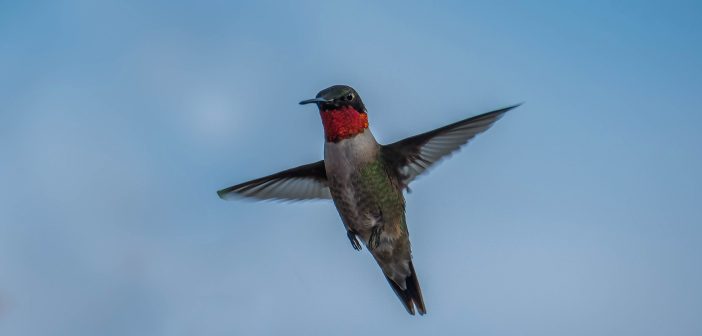
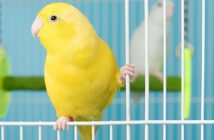


13 Comments
Pingback: Wood Turning Hummingbird Feeder Project
Favorites include rhododendrons, azaleas and rose of Sharon bushes. Bird Feeders Accessories
great post as usual!
Great work! Very informative and well-written.
.-= Neus´s last blog ..Learning Rx Cognitive Enhancement =-.
To clean and soak hummingbird feeders, IMHO 1 cup of bleach to 10 cups of water is too much bleach. For 10 cups of water, only 1 tablespoon of bleach would sanitize very well…or fill the feeder bottle with water and add 1 teaspoon of bleach to that and let set for 10 minutes. If there is black mold, scrubbing may be needed after the bleach soak…but black mold shouldn’t have time to form if the feeder is cleaned and the sugar water changed at least 2 times a week.
hummingbirdgrammy has great points! You need very little bleach if you need to use any at all. Vinegar is a decent alternative, too, adding just a tiny bit to your soaking water will help. But if you have black mold forming, you’re definitely leaving your feeder out way too long. Circulating the food regularly means very little effort in cleaning!
In super hot-weather, use just enough food for a couple days and change it out. In cooler weather, you can go longer between changing it out. It also helps if you place the feeder in the shade.
Thank you for reminding us that feeding the hummers is a commitment. You have shared some great info.
Hi, I love your blog. I am trying to find out all there is to know on hummingbirds. They are amazing how they just seem to hover so effortlessly whilst feeding.
This post is really great. It nice that you are able to come up with an interesting idea on making your own food for your hummingbirds. They are such exquisite kind of birds.
Making your own hummingbird food is economical and also it is much safer since we know what our birds eat since we make it ourselves instead of buying it in pet shops.
This post is really full of information. I haven’t tried making food for hummingbirds since I usually buy it from the store. This is quite economical. I’ll try to make some one of these days.
Great tips on how to find the perfect hummingbird feeder and make their food. And you’re so right about not using red food coloring. I was sceptical at first, but it made no difference without the red so I never use the coloring now.
Thanks for sharing.
Geoff
You ought to be a part of a contest for one of the best sites on the net.
I am going to highly recommend this website!